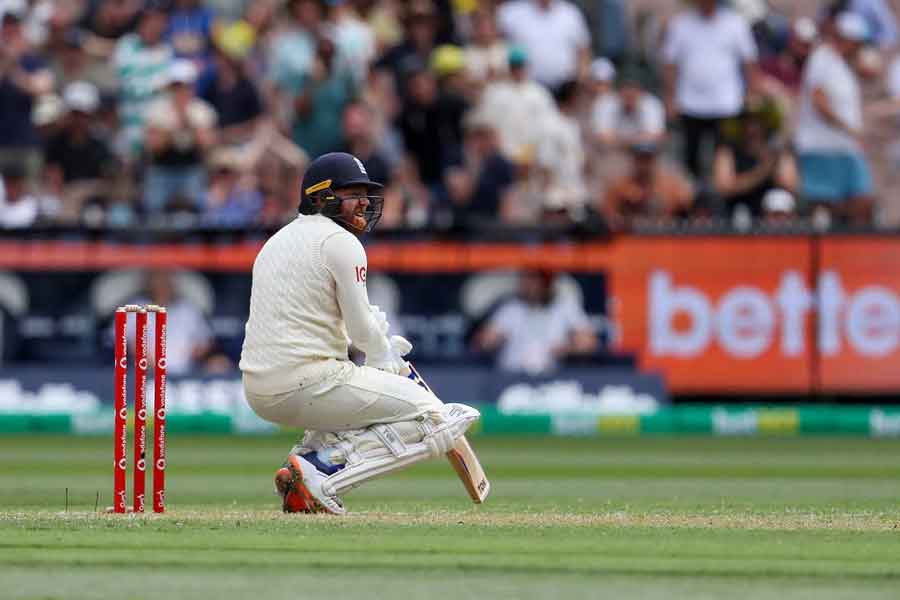A spectre is haunting cricket, its own ghost. The good news is that we might be able to bottle the spirit of the game, stopper it and toss this malignant genie into the Thames. Alex Carey’s stumping of Jonny Bairstow in the fourth innings of the Lord’s Test and the furore that ensued was a clarifying moment.
Central to the laws of cricket is a simple rule: for all the time that the ball is in play, a batter out of his crease is liable to be stumped or run out. The English position, as set out by Stokes, Bairstow, Broad and McCullum, is that careless English batters who wander beyond the crease, should not be stumped by wicket-keepers standing back. It’s ironic that in a game that has normalised batters standing their ground after nicking off instead of doing the classic spirit-of-cricket thing and walking, players like Broad and assorted pundits should choose to outrage over a legal dismissal that involves no deceit.
These critics aren’t constrained by their own prescriptions. Bairstow tried to stump Marnus Labuschagne in exactly this way in the first innings of this very Test. Stokes’ lawyerly response when this was put to him, was that Bairstow’s attempt didn’t come off the last ball of the over. The problem with this defence is that in the republic of cricket, every ball of every over is equal.
England’s manager, Brendon McCullum, notorious for running out Muttiah Muralitharan when the off-spinner left his crease to celebrate his batting partner’s century, was morally outraged by another wicket-keeper following his quick-witted example. His defence is that he had matured as a cricketer and now believed that such dismissals were wrong.
Stokes and McCullum might be sincere in their protestations, but their attempts to distinguish their sins from the sins of others make a compelling case for playing cricket by its laws and not according to a fluctuating understanding of fair play. Spirit-of-cricket-wallahs have the habit of taking the batter’s part, whether it’s the Mankad or, dare I say, the Carey. Batters are assumed to exist in an absent-minded state of innocence that demands the benefit of the doubt. Mike Marqusee, the great socialist historian of cricket, would recognise this for what it is: batting gents versus bowling proles.
Carey’s critics weren’t merely asking for the benefit of the doubt; they wanted Bairstow to have another dig. From Stokes, to McCullum, to Test Match Special’s Jonathan Agnew and Alastair Cook, SOC’s English evangelists wanted Pat Cummins to withdraw the appeal and allow Bairstow to resume his innings. This is literally the dvija case for the twice-born batter. Ashis Nandy was right: cricket is an Indian sport accidentally discovered by the English.
As a rule, critics of the Mankad are the same people as critics of the Carey. The argument against both forms of dismissal is that they aren’t effected through the exercise of cricketing skill and are, therefore, devious ambushes unless preceded by a warning. But some critics think the Mankad is a fair dismissal because the batter is trying to gain ground and the bowler has sound cricketing reasons for running him out. The distinction they make with the Carey is that Bairstow wasn’t trying to take a run and gain cricketing advantage. He thought the ball wasn’t in play and so to run him out on a technicality was a book-keeper’s trick, not cricket.
But Bairstow’s understanding of his situation does not independently determine the legitimacy of his dismissal. A ball is ‘dead’ when the batter and the fielding side agree that it is. ‘20.1.2 The ball shall be considered to be dead when it is clear to the bowler’s end umpire that the fielding side and both batters at the wicket have ceased to regard it as in play.’ In practice this consensus is signalled by a batter asking for permission to leave his crease and receiving it or, if it happens to be the last ball of the over, by the umpire saying ‘over’. Neither of these things happened in Bairstow’s case.
Carey’s critics routinely preface their objections with a disclaimer: they aren’t claiming that Bairstow wasn’t out. They follow this up by contending that the unwritten laws of the game acknowledge that cricket is full of non-playing interludes which should not be weaponised. This is why they expected Cummins to withdraw the appeal.
Cricket’s laws exist to provide unambiguous guidance, to set out a test that can be simply applied. This rhetorical two-step — the pro forma disclaimer followed by the invocation of the spirit of cricket — can be read as a claim that the laws should be re-written to cover edge cases. Perhaps the MCC could add a sub-clause that empowered the umpires to interpret the intent of the batter, allowing them to rule out a stumping if they thought the batter wasn’t trying to take a run.
How would this improve the law? The law as it stands is clear and unambiguous. ‘39.1.1 The striker is out Stumped…if he/she is out of his/her ground…and…he/she has not attempted a run when his/her wicket is fairly put down by the wicket-keeper without the intervention of another fielder.’
If the stumps are a batter’s castle, the crease is his moat. The law demarcates his safe zone. It outlines a general principle and when that principle is heeded, it covers every case. Cricket’s laws aren’t intended to accommodate a player’s lack of match awareness. The law goes to great lengths to explain when the ball is dead. The Carey controversy wasn’t caused by a loophole or lacuna in the law; it was the direct outcome of Bairstow’s defective understanding of it.
A law that complicates the definition of a dead ball by inviting the umpires to interpret the batter’s intention, lays up trouble by adding a layer of subjective judgment to a transparently clear law. Batters occasionally attempt quick singles when the ball goes through to a keeper standing deep. The keeper is entitled to regularly shy at the stumps to keep the batter honest. Consistency demands that every time that the batter is out of his ground and the stumps are broken, the batter be given out without accounting for his state of mind.
If the umpires felt that they had called or indicated ‘over’, they should have turned down Carey’s appeal without referring it to the third umpire. The onus is on Bairstow and the umpires; Carey and Cummins have no case to answer. Catching a batter out of his ground is part of a keeper’s job description. Carey was true to his keeper’s dharma. Cummins backed up his team-mate. For them to be accused of sharp practice or cheating is absurd.
The spectacle of a mob of MCC members booing the Australians as they entered the Long Room after Bairstow’s dismissal, was grotesque. A gang of entitled old men felt free to abuse their guests as cheats. The MCC’s apology doesn’t begin to make up for their behaviour. It would be in the spirit of cricket if visiting teams declared that they would play at Lord’s only if the Long Room was emptied of members for the duration of the Test. A cricket pavilion is a team’s refuge. Players shouldn’t have to run the gauntlet of a row of braying, blazered idiots and no team does, outside of Lord’s. If this is the conduct that the cult of the spirit of cricket produces, the game is better off anchored to the temperate lucidity of its Laws.










